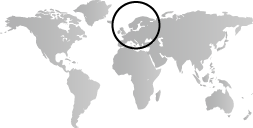The period between 2000 and 1000 B.C. marks the emergence of the region from isolation into contact with central and southern Europe. Horsemanship, metallurgy, and the long-distance export of fur and amber alter the forms of social organization and affect the types and styles of objects made here.
Eastern Europe and Scandinavia, 2000–1000 B.C.
Timeline
2000 B.C.
1750 B.C.
NORTHERN
EASTERN
1750 B.C.
1500 B.C.
NORTHERN
EASTERN
1500 B.C.
1250 B.C.
NORTHERN
EASTERN
1250 B.C.
1000 B.C.
NORTHERN
EASTERN
Overview
Key Events
-
ca. 2200–1600 B.C.
Kurgans, or burial mounds, distinguish the Late Neolithic culture of the Baltic and steppe. Important members of the community are buried in the ground with grave goods, and earth is heaped on top to create a mound. The custom may indicate a greater emphasis on elite households and the individual as opposed to collective commemoration of ancestors claimed by a whole community.
-
ca. 1800 B.C.
Adventurers from the Carpathian region pioneer trade routes to Scandinavia. Bronze weapons and jewelry travel northward in exchange for amber and perhaps furs. The bronze objects inspire northern artisans to imitate their forms in stone.
-
ca. 1700 B.C.
The Fat’janovo culture flourishes on the Upper Volga. Farmers with some knowledge of bronzeworking establish fortified hilltop villages with adjacent fields and pasture, and maintain constant contact with hunter-fisher cultures following a less settled, Mesolithic way of life.
-
ca. 1600–1500 B.C.
The peoples of Scandinavia and the Baltic region begin to acquire bronze technology. Since there are no local resources of tin or copper, they must expand long-distance trade with central and southern Europe. Amber proves the most valuable export, and demand for it reduces the isolation of northern Europe.
-
ca. 1600 B.C.
Schematized representations of boats appear in Scandinavia. The earliest example is incised on a bronze sword from Rørby, Denmark. Ships seem to be associated with trade and travel of various sorts—ordinary, heroic, and otherworldly. Boats are among the most frequent motifs on the engraved rock faces of Sweden, and ship-shaped stone enclosures often surround Scandinavian burials, about 1300 B.C. and after.
-
ca. 1550–1300 B.C.
Individual burials in tree-trunk coffins are common in Scandinavia. Toward the end of the period, cremation becomes more widespread.
-
ca. 1300 B.C.
A stone from a tumulus at Bredarör in southern Sweden is carved with an image of a two-wheeled chariot drawn by a pair of horses. The stone suggests both the use of the chariot and the prevalence of aristocratic ideals in Bronze Age Scandinavia. The “Chariot of the Sun,” a representation of a horse pulling a gilded bronze disk on a cart, is made and deposited in a bog in Denmark. The disk, almost certainly a solar symbol, is taken as evidence of contemporary sun worship. Disks, perhaps with similar connotations, are also incorporated into attire. Women’s graves, for example, sometimes include large belt adornments decorated with spiral designs carefully fitted inside concentric circles.
Citation
“Eastern Europe and Scandinavia, 2000–1000 B.C.” In Heilbrunn Timeline of Art History. New York: The Metropolitan Museum of Art, 2000–. http://www.metmuseum.org/toah/ht/?period=03®ion=eue (October 2000)
